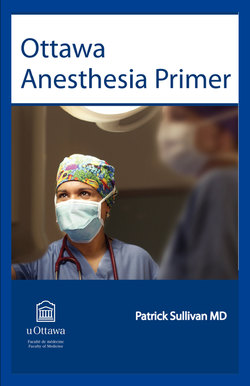Читать книгу Ottawa Anesthesia Primer - Patrick Sullivan - Страница 19
На сайте Литреса книга снята с продажи.
The Respiratory System:
ОглавлениеThere is wide spectrum of illness associated with the “common cold”. Patients with signs of severe systemic infection or pneumonia (fever, cough, purulent rhinitis, and rhonchi) are at an increased risk for adverse airway events during surgery. Following a complicated upper respiratory tract infection (URTI), hyper-reactive airways may require several weeks to normalize.11 There is no defined “safe period” to wait, and the decision to postpone anesthetic care should be left to the discretion of the attending anesthesiologist. It is important to ask patients about recent upper respiratory infections.
Cardiopulmonary pathophysiology associated with smoking includes an increased incidence of hypertension, tachycardia, and peripheral vascular disease (PVD). Cigarette smoke has been shown to decrease the clearance of pulmonary secretions and cause narrowing of the distal airways, leading to an increased frequency of bronchitis, asthma, and chronic obstructive pulmonary disease (COPD) (see below). Carbon monoxide forms a stronger bond with hemoglobin than oxygen, limiting oxygen delivery to the tissues. Patients who continue to smoke immediately prior to surgery will have an increased carboxyhemoglobin (COHb) level and are more prone to hypoxia during the postoperative period. Smoking also impairs wound healing and the immune response.12
It is important to quantitate the patient’s smoking history (number of packs/day multiplied by the number of years). A significant smoking history predisposes the patient to perioperative pulmonary complications.1,13 A systematic review showed that the best postoperative outcomes were achieved when an intensive cessation program was started 4 - 8 wk prior to surgery.14 This, however, should not discourage clinicians from encouraging smoking cessation when surgery is scheduled in less than four weeks. If the patient is unwilling to quit, stopping for at least 12 - 24 hr prior to surgery should abate the deleterious effects of nicotine and carbon monoxide within the body.
Patients with COPD are at an increased risk of perioperative respiratory complications.15 Anesthesia, surgery, and postoperative analgesia all predispose the patient with COPD to respiratory depression, atelectasis, retained secretions, pneumonia, and respiratory insufficiency or failure.
Symptoms of COPD may include a decreased exercise tolerance, chronic productive cough, and dyspnea. Respiratory examination may reveal decreased breath sounds, prolonged expiration, and active use of the accessory muscles of respiration. Expiratory wheezing, clubbing, and cyanosis may also be noted. Clinical assessment is generally as good or even better at predicting postoperative respiratory complications when compared with formal testing using pulmonary function tests and arterial blood gases.17
The cornerstones of preoperative optimization for patients with COPD include smoking cessation, avoidance of bronchospasm (e.g., preoperative bronchodilation with salbutamol), and treatment of acute COPD exacerbation (e.g., antibiotics for bacterial infections).
Asthmatic patients are prone to bronchospasm with tracheal intubation and exposure to cold, dry anesthetic gases. These patients should be asked about their use of bronchodilator therapy as well as inhalational and oral corticosteroid therapy. The patient’s medical history should also ascertain the frequency and severity of previous asthmatic attacks as well as the need for emergency care, hospitalization, intensive care admission, or tracheal intubation to manage asthma.18
Respiratory function in patients with restrictive lung disease, emphysema, and COPD will deteriorate following upper abdominal or thoracic surgery. This deterioration will increase the risk of postoperative respiratory complications. Prior to surgery, patients with limited respiratory reserve undergoing major surgery may benefit from investigations, including chest imaging, pulmonary function testing, and arterial blood gas analysis (assessment of pH, PaO2, PaCO2, and HCO3) to further gauge the severity of their disease and allow for proper anesthetic planning.
It may be difficult to provide positive pressure bag-mask ventilation (BMV) to patients with obstructive sleep apnea (OSA), and it may also be difficult to perform tracheal intubation in these patients using direct laryngoscopy. These difficulties may be due to an abundance of lax soft tissues in the upper airway.19 These patients also have an increased sensitivity to opioids, benzodiazepines, and volatile anesthetics, which can result in profound respiratory depression, hypoxia, and cardiorespiratory arrest in the postoperative period. Patients with OSA may require alternate or adjusted postoperative analgesic techniques, supplemental oxygen, and prolonged postoperative monitoring.20 Continuous positive airway pressure (CPAP) ventilation or bilevel positive airway pressure (BPAP) delivered by a facemask is frequently used in the treatment of patients with OSA. Information concerning the severity of OSA in these patients can be obtained from the findings of previous sleep studies and inferred from the level of pressure prescribed for their device. Patients should be questioned as to the set pressure on their device, and they should be instructed to bring their device on the day of their operation.
Patients with OSA frequently have symptoms of snoring, observed periods of apnea while sleeping, excessive daytime somnolence, and hypertension. A useful mnemonic to identify patients at risk for OSA is “STOP BANG”.21 A positive response to three of the eight criteria is 86% sensitive and 56% specific for the presence of OSA.
